Resources
 Part of the Oxford Instruments Group
Part of the Oxford Instruments Group
Expand
Collapse
 Part of the Oxford Instruments Group
Part of the Oxford Instruments Group
C-RED 2 ER is a highly sensitive extended short wave infrared (1100-1900 nm or 1300-2200 nm) camera. It is based on VGA (640x512 pixels) ER-InGaAs detector arrays and offers framerates up to 600 Hz. This camera is a real breakthrough, as it is the only one with such technology on the market. It opens new imaging and sensing opportunities for life science, defense, laser measurements, and industrial applications. This note is an introduction into the world of C-RED 2 ER.
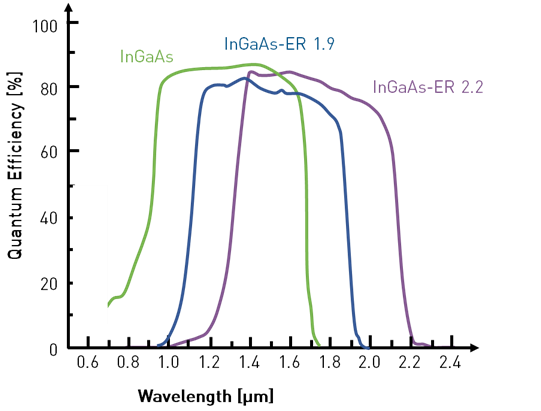
Comparison of the quantum efficiency curves for cameras based on standard InGaAs and extended range InGaAs (typical values).
InGaAs material absorbs light in the short wave infra-red spectrum and can be used as an optical detector in this range. Standard InGaAs-based detectors have a long wavelength cutoff of 1700 nm. They are fabricated by growing a crystalline layer of InGaAs on an indium phosphate (InP) substrate. In this case, the substrate has the same lattice constant as the alloy resulting in lattice-matching.
The sensitivity of InGaAs can be extended to higher wavelengths (up to 2.5 µm). Introducing more indium into the ternary compound decreases its bandgap and hence enables the detection of longer wavelengths. InxGa1-xAs with a longer cutoff is called "extended wavelength InGaAs.”
However, changing the composition of a ternary compound (InGaAs) will also change the lattice constant of the material. Adding a more InAs increases the lattice constant of the thin film, which causes a mismatch with the substrate, reducing the quality of the thin film. The more the lattice constant is shifted, the larger the mismatch. Lattice mismatching means more crystal structure defects, leading to raw images of poor quality. Until now, this has prevented extended SWIR imaging from becoming more widespread.
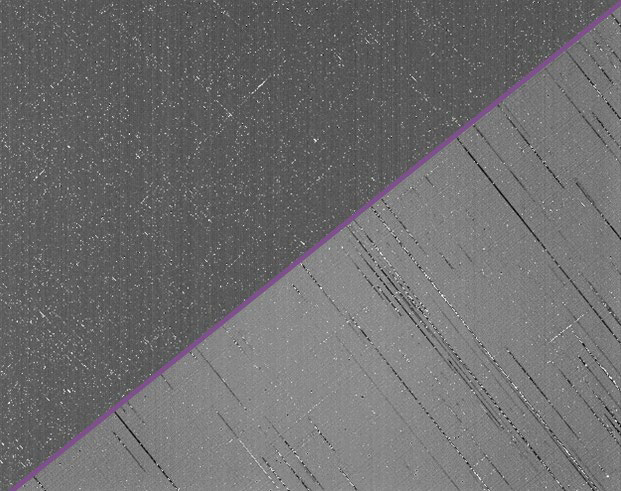
Raw image acquired in dark conditions with a C-RED 2 ER 1.9µm (top) and a C-RED 2 ER 2.2µm (bottom).
Acquisition parameters: medium gain, 600 fps, integration time 1.66 ms.
C-RED 2 ER is part of the C-RED range of cameras. It exists in two versions: C-RED 2 ER 1.9µm and C-RED 2 ER 2.2µm.
For more information on the performance of the camera, please refer to C-RED 2 ER : an extended range SWIR camera.
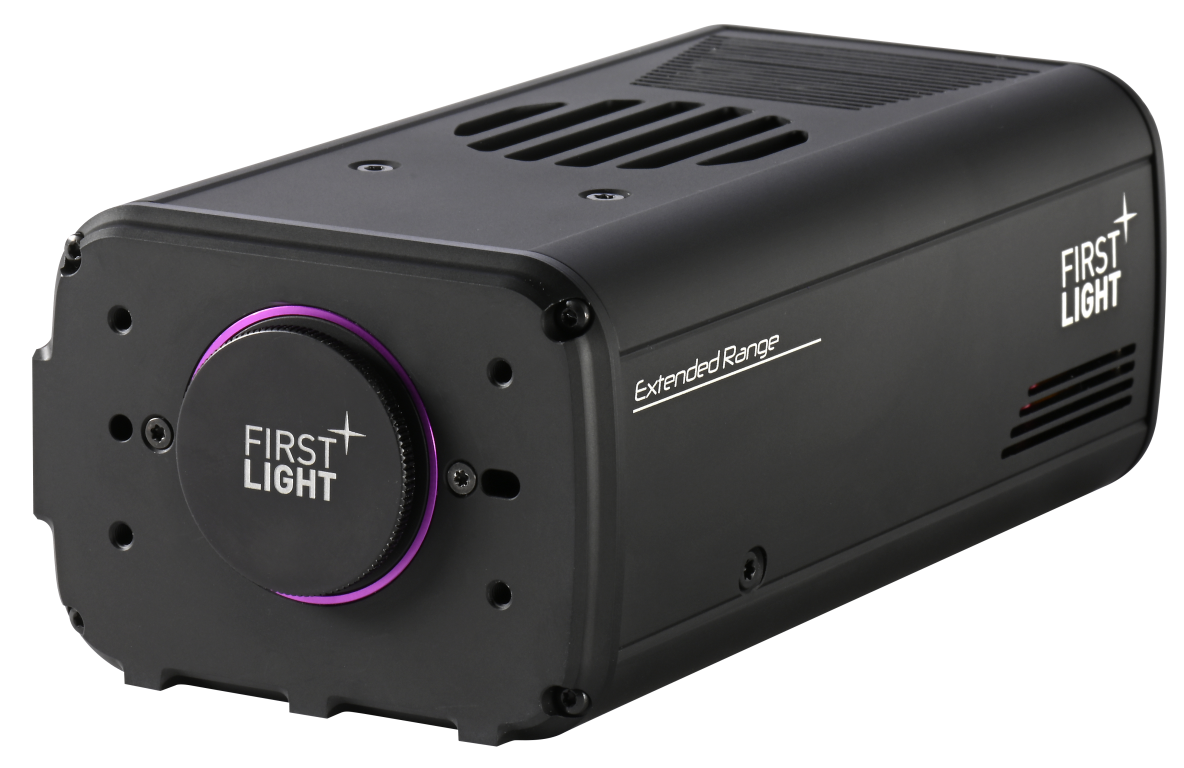
C-RED 2 ER camera
C-RED 2 ER is complementary to C-RED 2 in terms of sensitivity as it covers the high end of the SWIR spectrum.
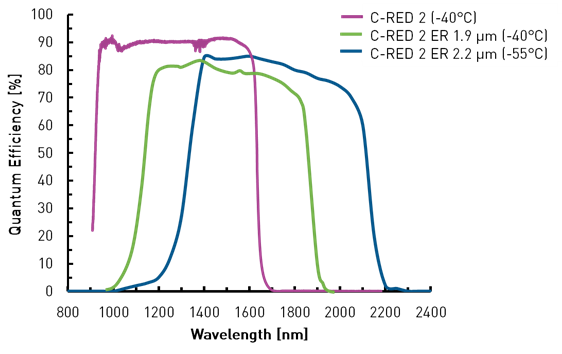 C-RED 2 and C-RED 2 ER cameras quantum efficiency curves
C-RED 2 and C-RED 2 ER cameras quantum efficiency curvesTo get the best imaging experience and reduce the lattice mismatch artefact, First Light Imaging recommends using the C-RED 2 ER cameras either at short integration times or with an optimized cooling.
Sensor temperature for C-RED 2 ER can be set anywhere from ambient temperature to -40°C or -55°C (depending on the camera version). Temperatures down to -15°C can be stabilized using air cooling only, while lower temperatures require using a liquid chiller. Cooling down the sensor optimizes the dark current and hence the performances of the camera. You can refer to the note ”C-RED 2 : long exposure time optimizations”. for more information.
First Light Imaging has developed a specific on-the-fly correction process to compensate the lattice mismatch artefacts of the extended range detector. The process corrects the image in real-time and can be applied to all gains and a large range of integration times. Importantly, the user has access to the image at all the steps of the process, including the initial raw image.
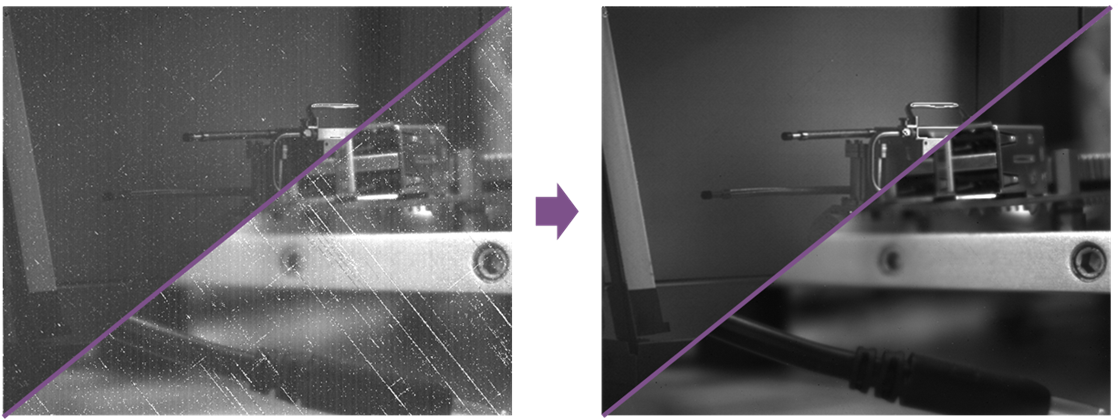 Images before and after applying the full correction process on a C-RED 2 ER 1.9µm (top) and a C-RED 2 ER 2.2 µm (bottom). Acquisition parameters: medium gain, water cooling
Images before and after applying the full correction process on a C-RED 2 ER 1.9µm (top) and a C-RED 2 ER 2.2 µm (bottom). Acquisition parameters: medium gain, water cooling
C-RED 2 ER enables high performance scientific imaging in the extended SWIR
range. The raw image is available. Alternatively, lattice mismatch artefacts can
be corrected on-the-fly.
Extended range InGaAs opens new perspectives in applications that require the detection of light with wavelengths further than the 1700 nm limit of standard InGaAs. Here is a short overview of some of the applications of C-RED 2 ER.
The first optical window (650 – 950 nm) has been widely used for clinical and preclinical fluorescence imaging. More recently, cameras sensitive to the NIR-II range have enabled to target the second optical window (1100 – 1350 nm). It is now used for in vivo small animal imaging and more recently for clinical applications. You can refer to the application note “in vivo NIR-II Small animal imaging with C-RED 2”. for further information.
Two more optical windows exist: the third (1600 – 1870 nm) and the fourth (centered at 2200 nm). The third window optimizes the scattering and absorption of tissues, hence the penetration of light in tissues [1] . It is ideal for deep brain imaging. Other applications such as Optical Coherence Tomography (OCT) will also benefit from the longer penetration depth of light.
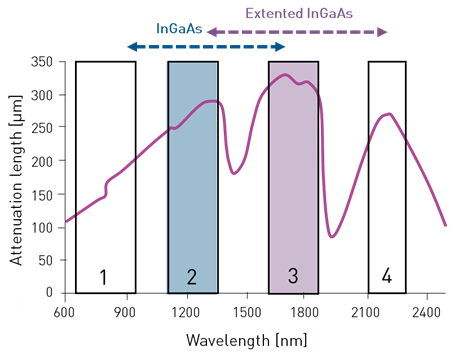 Transmittance in brain tissue of 200 µm thicknesses. Four optical windows are identified.
Transmittance in brain tissue of 200 µm thicknesses. Four optical windows are identified.Day and night vision in foggy weather conditions is a major concern for surveillance applications. Visible imaging has low performances in these conditions. Two major windows exist in the SWIR range for imaging through clouds and smoke: 1350 – 1400 nm and 1850 – 1900 nm. Watch our video : Maritime surveillance.
In military applications, extended range sensors are extremely interesting as they are capable of imaging light that cannot be seen by current night vision technologies. This permits to see “invisible” lasers that are currently being used on the battlefield.
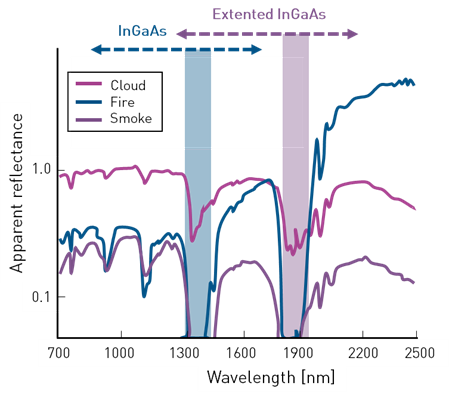 Reflectance spectra. Two windows are identified to “see through” various weather conditions.
Reflectance spectra. Two windows are identified to “see through” various weather conditions.Optical transmission in free space is influenced by disturbances such as fog, dust, and atmospheric turbulence. The use of the SWIR band (0.9 µm – 1.7 µm) has been shown to be extremely pertinent because of their ability to penetrate through obstacles such as fog or some types of plastics. The use of longer wavelengths combined to band path filters will likely optimize the penetration. Eye-safe lasers exist in both SWIR and ER-SWIR bands enabling the use of these wavelengths for free space communications. On this topic you can refer to the application note “Free Space Optical communications with C-RED 3” . C-RED 2 ER can be used as the wavefront sensor in an adaptive optics loop, for example.
Optimized optical transmission is a major asset for:
As a general rule, the error on a temperature measurement is higher for higher temperatures at longer wavelength. Hence, the SWIR and ERSWIR ranges are better than MWIR or LWIR at temperatures within the range 300°C to 1600°C. ER-SWIR, contrary to SWIR enables measurements at temperatures below 300°C thanks to the higher radiance.
Thermography has many applications, examples include:
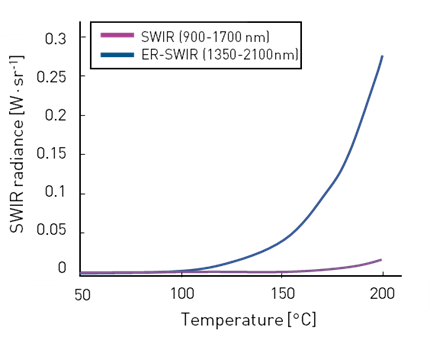 Theoretical radiance of a black body at low temperature integrated over the SWIR and ER-SWIR spectral ranges.
Theoretical radiance of a black body at low temperature integrated over the SWIR and ER-SWIR spectral ranges.Water has four absorption bands within the infrared region, at wavelengths 1200 nm, 1450 nm, 1940 nm and 2950 nm. Measuring the absorption of thin food slices or foliage at these wavelengths enables to quantitatively determine their water content [2] . On thicker objects, such as fruits and vegetables, the absorption properties allow to detect moisture or defects that are imperceptible in the visible range (by the naked eye). This is particularly useful for food sorting applications and observation of crop fields.
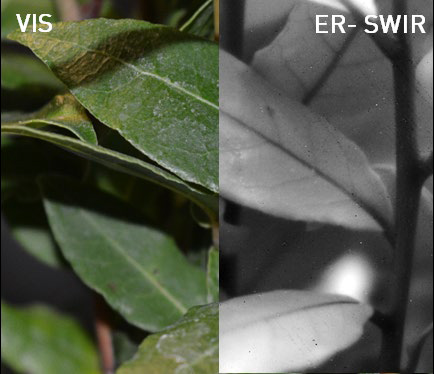
Visible versus ER-SWIR images of bay leaves.
SWIR and longer wavelength are interesting because they are invisible to the human eye. Hence, lasers in these ranges find numerous applications. One is LiDAR, which enables distance measurement by measuring the reflection of laser light. LiDAR systems often use lasers that emit light with a wavelength of 2.05 μm, which is beyond the detection limit of standard InGaAs. C-RED 2 ER can also be used for laser beam characterization and optical power measurements.
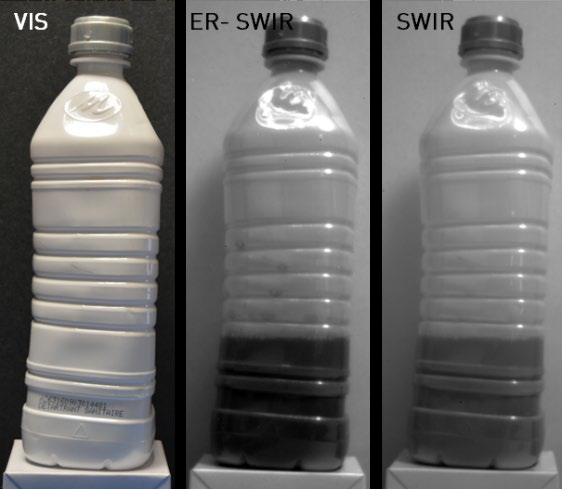
Visible versus SWIR and ER-SWIR images of a plastic bottle filled with water. The bottle is opaque in the visible range, while ER-SWIR increases the contrast compared to SWIR.
Imaging in the SWIR extended range is an entirely new field of research.
C-RED 2 ER is a key asset to push the doors of outstanding applications wide open!
C-RED 2 ER is a state-of-the-art camera, the only one using a 640 x 512 extended range InGaAs detector. It is designed for demanding applications. At First Light Imaging, we believe that C-RED 2 ER is opening an entirely new field of research in multiple domains, ranging from astronomy to agriculture.
C-RED 2 ER enables high quality sensing at extremely fast framerates (up to 600 FPS) and short integration times. To answer your needs the camera can output a completely raw image or a corrected one. The ER-specific correction process that is implemented is based on the physics of detectors and optimizes your acquisition in real-time without losing either resolution or physical meaning of the image. Thanks to these different acquisition modes, C-RED 2 ER is very flexible and perfectly suited for numerous applications.
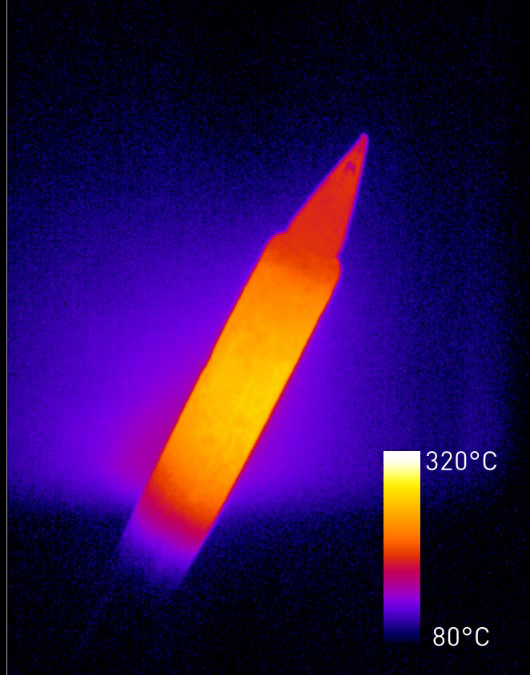
Thermal imaging with C-RED 2 ER of a soldering iron tip heated at 250°C.
Date: April 2022
Author: Cecile Brun
Category: Application Note
